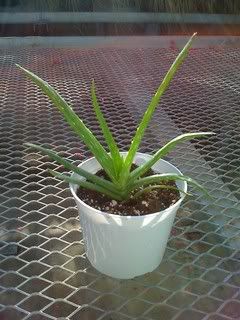Aloe vera

People everywhere are intrigued by the natural benefits offered by Aloe vera making it one of the most popular succulent plants available. The Aloe plant has fleshy leaves that can grow to be two feet long and when taken from the plant they exude a cooling gel that can be used to treat sunburns, among other things. The leaves are identifiable by their alternating pattern originating from a single point of growth, white or reddish teeth along the edges, and light spots all over.
 To use the plant’s gel for scrapes, abrasions, or burns, take the lowest leaf from the plant. The plant will heal itself without any problems and using leaves from the bottom up will keep the plant looking nice. New leaves will continue to grow from the top.
To use the plant’s gel for scrapes, abrasions, or burns, take the lowest leaf from the plant. The plant will heal itself without any problems and using leaves from the bottom up will keep the plant looking nice. New leaves will continue to grow from the top.
Aloe vera prefers bright but diffuse light. An eastern or western window works well if the plant is set back a couple of feet. North of the equator, southern windows should be avoided unless there is a sheer curtain providing some protection. A northern window may work, but growth will be slow and on the weak side.
Succulent plants have more to fear from over-watering than under-watering. Water your Aloe when the potting mix is quite dry. If it still feels damp, wait a little longer. To help prevent an over-watering accident, make sure that your Aloe is potted in a potting mix that has excellent drainage such as a cacti/succulent mix. Be sure that there are drainage holes in the bottom of the pot, as well.
Aloe doesn’t need much in the way of fertilization, so it is okay to use whichever fertilizer you are already using on your other houseplants with this one. Once a month is plenty; if you fertilize more frequently than that you may see damage.
Propagation of Aloe is extremely easy, as these plants love to send out offshoots. Remove an offshoot from the mother plant when it has enough roots of its own to survive and place it in its own pot. Just a few roots are needed, but the more the better. I like to wait until the last moment when it’s almost too difficult to separate the plants.
There are conflicting reports about whether or not this plant is toxic if ingested. I have to admit that I am not an herbalist and am not personally aware of the safety of taking this plant internally. If you plant on simply growing this plant for a visual point of interest or for topical use, then by all means, you are in the clear. I have had my cats chew on this plant without any issues, but that doesn’t mean large amounts are okay. Just be aware that there are differing opinions out there.

Aloe vera prefers bright but diffuse light. An eastern or western window works well if the plant is set back a couple of feet. North of the equator, southern windows should be avoided unless there is a sheer curtain providing some protection. A northern window may work, but growth will be slow and on the weak side.
Succulent plants have more to fear from over-watering than under-watering. Water your Aloe when the potting mix is quite dry. If it still feels damp, wait a little longer. To help prevent an over-watering accident, make sure that your Aloe is potted in a potting mix that has excellent drainage such as a cacti/succulent mix. Be sure that there are drainage holes in the bottom of the pot, as well.
Aloe doesn’t need much in the way of fertilization, so it is okay to use whichever fertilizer you are already using on your other houseplants with this one. Once a month is plenty; if you fertilize more frequently than that you may see damage.
Propagation of Aloe is extremely easy, as these plants love to send out offshoots. Remove an offshoot from the mother plant when it has enough roots of its own to survive and place it in its own pot. Just a few roots are needed, but the more the better. I like to wait until the last moment when it’s almost too difficult to separate the plants.
There are conflicting reports about whether or not this plant is toxic if ingested. I have to admit that I am not an herbalist and am not personally aware of the safety of taking this plant internally. If you plant on simply growing this plant for a visual point of interest or for topical use, then by all means, you are in the clear. I have had my cats chew on this plant without any issues, but that doesn’t mean large amounts are okay. Just be aware that there are differing opinions out there.
This site needs an editor - click to learn more!
You Should Also Read:
Recognizing and Treating Root Rot
Summering Houseplants Outdoors
Houseplants Newsletter
Related Articles
Editor's Picks Articles
Top Ten Articles
Previous Features
Site Map
Content copyright © 2023 by Lisa Beth Voldeck. All rights reserved.
This content was written by Lisa Beth Voldeck. If you wish to use this content in any manner, you need written permission. Contact
BellaOnline Administration
for details.


